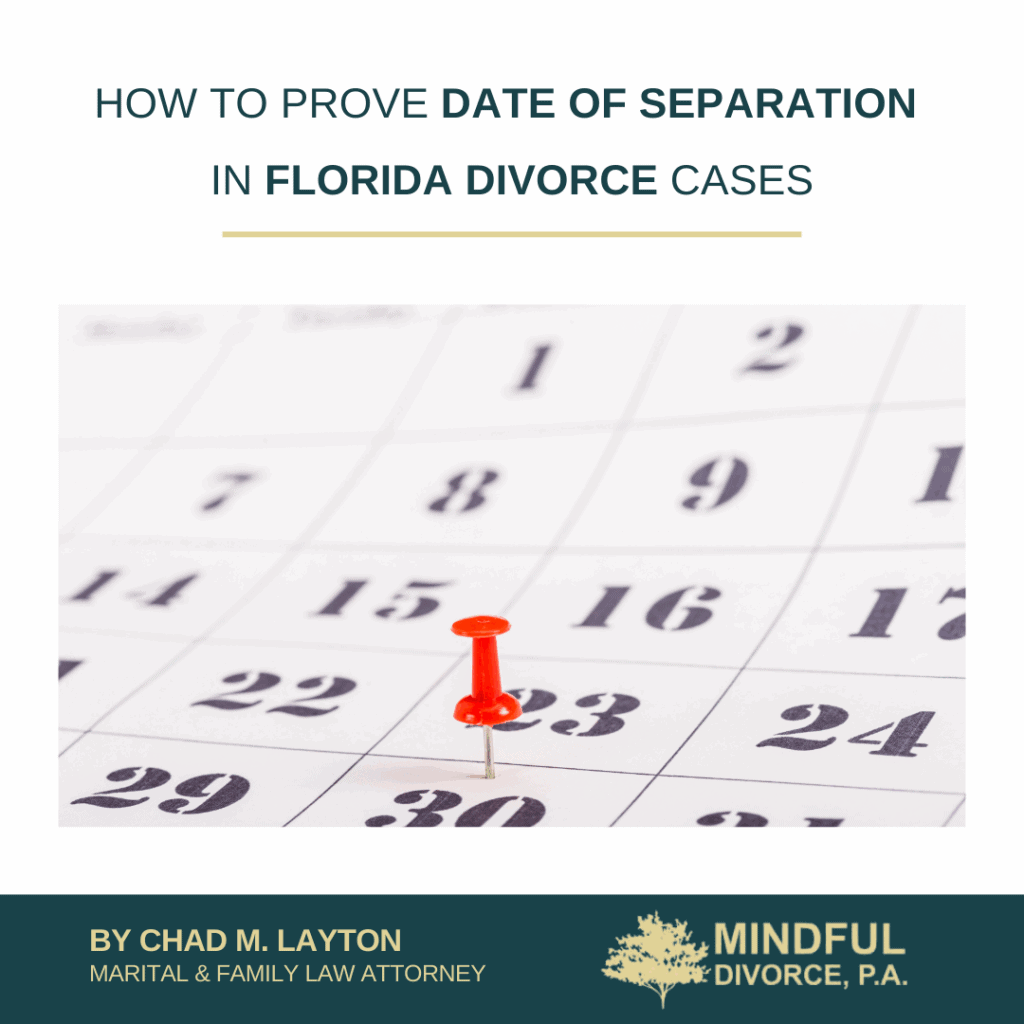
The decision to end a marriage is rarely simple, and pinpointing the exact date of separation can bring added stress.. This date plays a key role in Florida divorce cases, affecting issues like property division and support.
At Mindful Divorce, P.A., we aim to make the legal process as clear and predictable as possible through our fixed-fee approach. In this article, we’ll explain why the date of separation matters, how to prove it, and what it means for your case as you move toward resolution.
Why the Date of Separation Matters in Florida Divorce Cases
Florida does not provide a formal process for legal separation. Instead, the law treats couples as still married until a court finalizes their divorce or until both spouses take steps that show they no longer wish to be together.
The date of separation is critically important for issues like classifying and dividing marital assets and debts, as outlined in Fla. Stat. § 61.075. This date can guide a court’s decisions about what counts as “marital property” versus what you or your spouse will keep as personal property. For instance, if someone racks up new credit card debt after separating, it may not be treated as a shared responsibility.
By pinpointing a particular date when it became obvious the relationship was ending, each spouse can better address how to value the assets owned, as well as any financial interests that might have accrued after that time. This helps the court arrange a more accurate approach to property division and overall fairness.
A gap often arises between physically moving away and filing for divorce. Nonetheless, the separation date can shape decisions on matters like retirement accounts, vehicles purchased after splitting, and even liabilities taken on by a single spouse once the marriage was on its way out.
What is the Date of Separation in Florida?
In this state, living “separate and apart” is more than just talking about ending the relationship; it requires actual steps demonstrating an intent to stop living as a married couple. That might include no longer sharing a bedroom, halting financial commingling, or beginning to date someone else with openness about the split.
Formal documents like a Petition for Dissolution of Marriage can also serve as a guideline for the separation date. Still, couples should be aware that a court may rely on other evidence if filing for divorce happens long after the marriage truly broke down. The essential factor is showing that at least one spouse decided to discontinue the marital bond and started living apart in a practical sense.
Once couples no longer function as a single household—in terms of finances, daily life, or intimate connections—the law often considers that to be a genuine date of separation. Actions speak louder than words, so courts will usually look at where each spouse lives, maintains finances, and how they interact day to day to find the date that best suits the facts at hand.
Acceptable Evidence for Proving Your Separation Date
Courts generally expect clear proof of when a marriage ended. If the spouses disagree, the judge may need to consider witness statements, written records, or financial documents that underscore when the parties started living separate lives. Below is a quick look at ways to build your case that the separation truly began on a particular date.
Establishing Intent to End the Marriage
An important first step is to show that one or both spouses genuinely intended to bring the marriage to a close. You can demonstrate intent using communications or steps taken to inform friends and family that the partnership was over. Text messages, emails, or social media posts that describe intentions to separate are often helpful.
Common examples of proof could include:
- Messages telling friends or relatives that you are ending the marriage
- Statements in which you outline plans to move out or file for divorce
- Spouse reactions and admissions in writing about the split
Though a court will not rely solely on one text or email, each piece of evidence can help build a consistent timeline.
Physical Separation
Another key element is showing that you and your spouse stopped living together as a united household. While it is possible to live side by side and still be viewed as separated, physical proof of separate spaces often makes for a stronger case. Some examples include moving out of a shared home or shifting to a different bedroom full-time.
When you take steps to live apart—whether in the same house or a new address—you help confirm that the marriage was no longer fully functioning. Documenting these moves can be done through:
- Rental or lease agreements for a separate apartment
- Utility bills directed to another living space
- Affidavits from neighbors or family attesting to your new housing arrangement
Financial Independence
Cutting financial ties is a telling sign that you both acted as single individuals. Courts look for evidence of opening new bank accounts, ceasing joint credit cards, or otherwise handling money separately right around the date of separation. Even if you did not move out physically, creating distinct economic pathways might indicate that the marriage was ending.
The following moves are often presented to confirm that finances were split:
- Opening an independent checking or savings account
- Canceling joint auto or health insurance policies
- Notifying your job’s human resources about changes in beneficiary forms
Changing Living Arrangements
A formal change of address with the post office or driver’s license office can also bolster your claim. Even an informal switch, such as telling your employer and acquaintances that you are living somewhere else, suggests a new normal. If you keep day-to-day life separate, keep track of receipts, rental agreements, or letters delivered to your new place.
Below is a table summarizing common forms of proof and their potential effect on establishing that a separation date existed:
| Type of Document | Potential Impact |
| Text Conversations | Demonstrates timeline and intent |
| Rental Agreements | Verifies a separate residence or living space |
| Bank Statements | Shows independent financial arrangements |
| Witness Declarations | Supports claims of separate life choices |
Assets and Debts After Separation
In Florida, assets and obligations are typically labeled “marital” or “non-marital.” Anything that arises after separation may not land in the shared category. This means that if you purchase an expensive car once you have separated and do so without any joint funds, the court can consider it your separate property.
The same logic holds true for debts. If your spouse goes on a pricey trip or charges large costs on a personal card after the marriage ended, in practice, a court will usually decide that the debt belongs to them alone. This can be a powerful reason to establish your date of separation, so you are not tied to the burdens your partner took on after you parted ways.
Thorough records showing when you acquired property, opened new accounts, or took on expenses can reduce confusion in court. Create an organized file that captures your marital finances before separation and your independent dealings once you have shifted to separate living. This helps clarify what belongs to whom and can reduce disagreements down the road.
How a Knowledgeable Attorney Can Assist
If you feel uncertain about collecting statements or verifying a specific separation date, a lawyer can step in to help. Attorneys routinely gather emails, text messages, and other documents to fix a separation date that serves a client’s interests. They can also craft strong arguments to show why debts or assets should be classed as personal rather than shared.
Lawyers can recommend what evidence a judge will find more persuasive and prepare you for any questions about living arrangements during the separation. Having a legal ally on your side can simplify an already emotional process, and it may spare you unnecessary conflict.
An attorney can also present reasons for the court to use a date of separation earlier than the official divorce filing if that better fits your timeline. At times, couples drift apart months or years before the paperwork is submitted, and experienced counsel can push to recognize that earlier date.
Seeking a Compassionate Divorce Attorney in Florida?
At Mindful Divorce, P.A., we aim to offer calm and steady guidance through each phase of your divorce. Our fixed-fee services bring clarity so you can avoid worrying about billing surprises. If you have questions or want a fresh perspective on your separation date, call us at 561.537.8227 or visit our Contact Us page. We stand ready to discuss your path forward so you can focus on what matters most in this next chapter.



